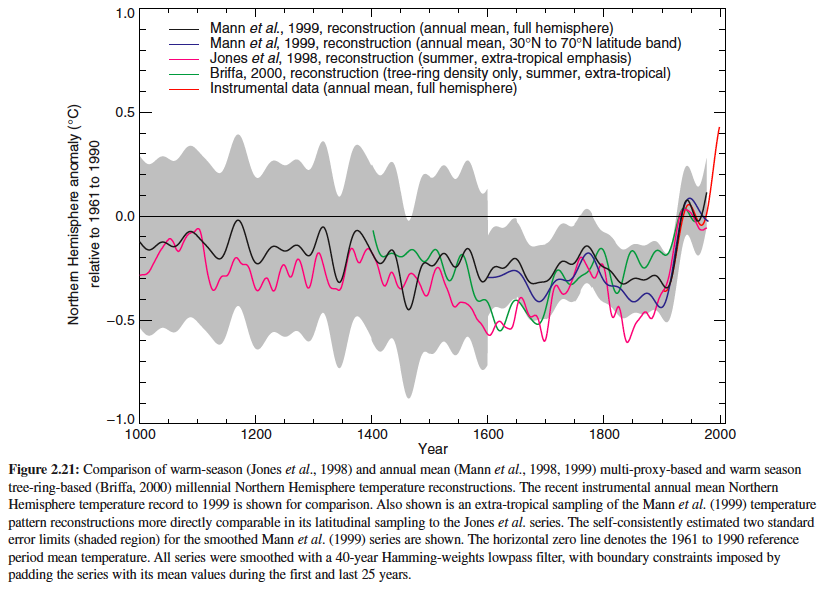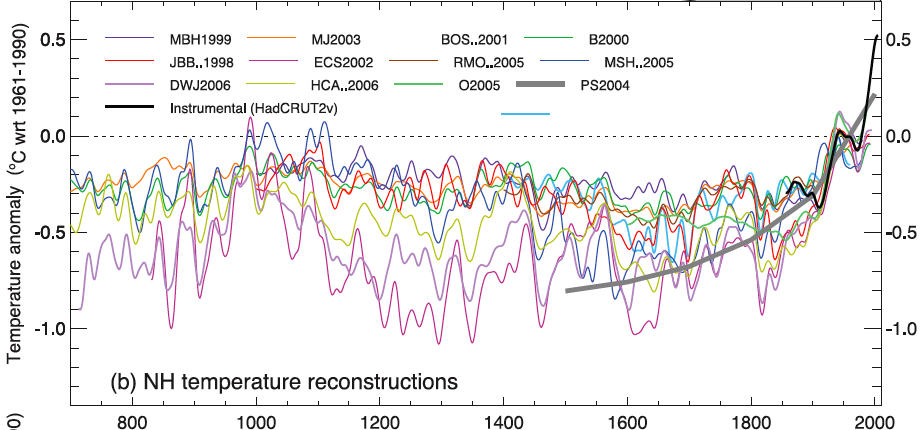
In a recent post on her blog, climate scientist Judith Curry made some rather extreme comments regarding the IPCC and "hiding the decline" (emphasis added):
“There is no question that the diagrams and accompanying text in the IPCC TAR, AR4 and WMO 1999 are misleading. I was misled. Upon considering the material presented in these reports, it did not occur to me that recent paleo data was not consistent with the historical record....It is obvious that there has been deletion of adverse data in figures shown IPCC AR3 and AR4, and the 1999 WMO document. Not only is this misleading, but it is dishonest (I agree with Muller on this one). The authors defend themselves by stating that there has been no attempt to hide the divergence problem in the literature, and that the relevant paper was referenced. I infer then that there is something in the IPCC process or the authors’ interpretation of the IPCC process (i.e. don’t dilute the message) that corrupted the scientists into deleting the adverse data in these diagrams."
The "divergence problem", as previously discussed by John, refers to the fact that some high latitude tree rings seem to indicate that temperatures have decreased since about 1960, when of course we know temperatures have in reality increased rapidly over that period. Curry's comments relate to a few graphs which have cut off the tree ring data around 1960, and included data from the instrumental temperature record, which we know accurately reflects global temperatures.
The World Meteorological Organization (WMO) document in question was an obscure report, for which a figure was provided for its cover depicting both instrumental temperature data and reconstructed temperatures based on tree rings. Criticisms of this figure are valid, as the methods used to create it are not discussed in the report. However, as noted above, the report was rather obscure, so here we will focus on Curry's criticism of the much more prominent IPCC Third Assessment and Fourth Assessment Reports (TAR and AR4).
The controversy in question surrounds the presentation of Keith Briffa's tree ring data. The only millennial temperature reconstruction presented in the IPCC TAR Summary for Policymakers was the Mann et al. "hockey stick", so Curry's criticisms can only apply to Chapter 2 of Working Group 1 (WG1), which presented reconstructions from Mann et al. (1999), Jones et al. (1998), and Briffa (2000) in Figure 2.21:

It's true that Briffa (2000) included data up to the year 2000, whereas the study's tree ring data presented in this figure is truncated at the year 1960. And it's true that this fact is not specifically noted in the text or the figure caption. However, note that the full instrumental temperature record is included (it's not simply spliced to the end of the proxy data), as is specifically mentioned in the caption. Thus the only potentially valid remaining criticism of the IPCC TAR regarding "hide the decline" is the truncation of Briffa's tree ring data. Returning to Curry's accusations:
"I was misled. Upon considering the material presented in these reports, it did not occur to me that recent paleo data was not consistent with the historical record"
Section 2.3.2.1 of the IPCC TAR WG1 (Paleoclimate proxy indicators) has a sub-section devoted to a detailed discussion of tree ring data, including the following text (Page 131), emphasis added:
There is evidence, for example, that high latitude tree-ring density variations have changed in their response to temperature in recent decades, associated with possible nonclimatic factors (Briffa et al., 1998a). By contrast, Vaganov et al. (1999) have presented evidence that such changes may actually be climatic and result from the effects of increasing winter precipitation on the starting date of the growing season (see Section 2.7.2.2). Carbon dioxide fertilization may also have an influence, particularly on high-elevation drought-sensitive tree species, although attempts have been made to correct for this effect where appropriate (Mann et al., 1999). Thus climate reconstructions based entirely on tree-ring data are susceptible to several sources of contamination or non-stationarity of response. For these reasons, investigators have increasingly found tree-ring data most useful when supplemented by other types of proxy information in “multi-proxy” estimates of past temperature change (Overpeck et al., 1997; Jones et al., 1998; Mann et al., 1998; 1999; 2000a; 2000b; Crowley and Lowery, 2000).”
This seems like a very clear and explicit discussion of the shortcomings of high latitude tree rings as an accurate temperature proxy over the past several decades, some possible reasons for the divergence, and how the divergence problem should be treated (by supplementing it with other proxies). Given this detailed discussion, Curry's accusations that with regards to the divergence problem, "there is no question" that the IPCC authors were "misleading", "corrupted", and "dishonest" become very difficult to justify. Even moreso when we examine the next target of her criticisms: AR4.
As with the TAR, the tree ring proxy data and divergence problem discussion in the IPCC AR4 is quite detailed and explicit. Below is the relevant discussion from AR4 WG1 Section 6.6.1.1 (Page 472-473), emphasis added:
“Several analyses of ring width and ring density chronologies, with otherwise well-established sensitivity to temperature, have shown that they do not emulate the general warming trend evident in instrumental temperature records over recent decades, although they do track the warming that occurred during the early part of the 20th century and they continue to maintain a good correlation with observed temperatures over the full instrumental period at the interannual time scale (Briffa et al., 2004; D’Arrigo, 2006). This ‘divergence’ is apparently restricted to some northern, high latitude regions, but it is certainly not ubiquitous even there. In their large-scale reconstructions based on tree ring density data, Briffa et al. (2001) specifically excluded the post-1960 data in their calibration against instrumental records, to avoid biasing the estimation of the earlier reconstructions (hence they are not shown in Figure 6.10), implicitly assuming that the ‘divergence’ was a uniquely recent phenomenon, as has also been argued by Cook et al. (2004a). Others, however, argue for a breakdown in the assumed linear tree growth response to continued warming, invoking a possible threshold exceedance beyond which moisture stress now limits further growth (D’Arrigo et al., 2004). If true, this would imply a similar limit on the potential to reconstruct possible warm periods in earlier times at such sites. At this time there is no consensus on these issues (for further references see NRC, 2006) and the possibility of investigating them further is restricted by the lack of recent tree ring data at most of the sites from which tree ring data discussed in this chapter were acquired.”
Again, there is a very explicit discussion of the divergence problem (even moreso than in the TAR), of its possible causes, and how it should be dealt with scientifically. In this case, the text specifically states that the post-1960 data is excluded from the Briffa et al. (2001) data plotted in Figure 6.10:

Curry's criticisms of IPCC AR4 don't seem the least bit warranted. The tree ring data and divergence problem are discussed in detail, and the data which is excluded from the relevant figure is specifically mentioned.
When we examine these reports, Curry's criticisms really seem to boil down to the fact that IPCC TAR Figure 2.21 truncated the data from Briffa (2000) without explicitly stating so. Is this sufficient to warrant Curry's accusations that the IPCC authors were "misleading", "corrupted", and "dishonest"?
Climate scientist Gavin Schmidt weighed in with his opinion on this question in Curry's blog post comments:
"Accusations of dishonesty are way beyond a difference of opinion on how a graph should be displayed...Summary graphs are by their very nature, summaries. The graphs you pick out were summaries of various estimates of what paleo-temperature estimates from the literature were. It is therefore not surprising that they show only the reconstructions where the authors had confidence that the reconstructions were actually of the temperatures.Problems with modern divergence – which only applies to the Briffa et al curve in any case – are issues to be dealt with in the technical literature, as they still are."
This seems like a fair assessment. IPCC TAR Figure 2.21 was intended to summarize temperatures over the past millennium as accurately as possible. Briffa and his collaborators felt that their tree ring data did not accurately represent temperatures after 1960, so they truncated it and only provided data up to 1960 to the IPCC. Perhaps the IPCC report should have explicitly stated that Figure 2.21 excluded the post-1960 tree ring data, but the associated Chapter did contain a discussion of the shortcomings of northern latitude tree ring density measurements over the past few decades. Perhaps they should have included Briffa's full data set, but that's a subjective decision, and obviously the authors were not confident that the truncated data accurately reflected temperatures, and for good reason.
Curry's extreme accusations regarding the IPCC TAR author's motives certainly don't seem justified in light of the evidence discussed here, and even less so in AR4, which was very clear in discussing the divergence problem.
The TAR authors' subjective decision to truncate the tree ring data in Figure 2.21 can certainly be debated, but when the discussion turns away from the science and toward inferences about the authors' motives, a civil and intelligent discourse becomes almost impossible. We join Bart Verheggen's previous calls for Judith Curry to resume attempting to build bridges between the two sides of the climate 'debate' rather than burning them, by toning down the unnecessary and unwarranted accusatory rhetoric. It's certainly possible to discuss other scientists' subjective decisions without resorting to accusations about their honesty and motives, and doing so will lead to a less inflamed and more constructive discussion.
Posted by dana1981 on Monday, 28 February, 2011
 |
The Skeptical Science website by Skeptical Science is licensed under a Creative Commons Attribution 3.0 Unported License. |